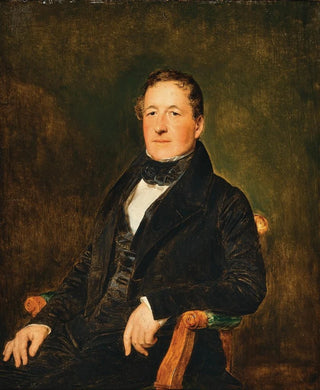Art print | Portrait of Friedrich Eltz 1782-1855 - Ferdinand Georg Waldmüller


View from behind

Frame (optional)
In the realm of 19th-century Austrian painting, the portrait of Friedrich Eltz by Ferdinand Georg Waldmüller stands out for its emotional depth and striking realism. Created in 1855, this art print embodies not only the legacy of an influential man of his time but also the essence of an era where art reflects societal aspirations and values. The piece, through its meticulous details and subtle lighting, invites us to delve into the subject's intimacy, revealing an authentic connection between the artist and his model. The art print of Friedrich Eltz 1782-1855 by Ferdinand Georg Waldmüller allows for appreciation of this work in all its splendor, offering a gateway to a world rich in history and emotion.
Style and uniqueness of the work
Waldmüller’s style is characterized by pronounced naturalism, where each stroke and color is carefully chosen to convey not only Friedrich Eltz’s physical appearance but also his inner essence. The subject’s penetrating gaze, combined with a thoughtful posture, immediately captures the viewer’s attention. The nuances of light and shadow, skillfully orchestrated, give the composition an almost three-dimensional quality, making the portrait come alive. The texture of the clothing, the details of the accessories, and the carefully selected background contribute to creating an atmosphere that evokes both dignity and melancholy. Waldmüller succeeds in transcending the simple exercise of portraiture to offer a true psychological study, where the viewer is invited to ponder the thoughts and emotions of the depicted character.
The artist and his influence
Ferdinand Georg Waldmüller, a prominent figure in Austrian painting, knew how to mark his era with an innovative approach that combines tradition and modernity. Trained within the Romantic movement, he developed a style that emphasizes meticulous observation of nature and human beings. His work is distinguished by particular attention to detail and light, elements that allow him to capture the soul of his subjects. Waldmüller also

Matte finish

View from behind

Frame (optional)
In the realm of 19th-century Austrian painting, the portrait of Friedrich Eltz by Ferdinand Georg Waldmüller stands out for its emotional depth and striking realism. Created in 1855, this art print embodies not only the legacy of an influential man of his time but also the essence of an era where art reflects societal aspirations and values. The piece, through its meticulous details and subtle lighting, invites us to delve into the subject's intimacy, revealing an authentic connection between the artist and his model. The art print of Friedrich Eltz 1782-1855 by Ferdinand Georg Waldmüller allows for appreciation of this work in all its splendor, offering a gateway to a world rich in history and emotion.
Style and uniqueness of the work
Waldmüller’s style is characterized by pronounced naturalism, where each stroke and color is carefully chosen to convey not only Friedrich Eltz’s physical appearance but also his inner essence. The subject’s penetrating gaze, combined with a thoughtful posture, immediately captures the viewer’s attention. The nuances of light and shadow, skillfully orchestrated, give the composition an almost three-dimensional quality, making the portrait come alive. The texture of the clothing, the details of the accessories, and the carefully selected background contribute to creating an atmosphere that evokes both dignity and melancholy. Waldmüller succeeds in transcending the simple exercise of portraiture to offer a true psychological study, where the viewer is invited to ponder the thoughts and emotions of the depicted character.
The artist and his influence
Ferdinand Georg Waldmüller, a prominent figure in Austrian painting, knew how to mark his era with an innovative approach that combines tradition and modernity. Trained within the Romantic movement, he developed a style that emphasizes meticulous observation of nature and human beings. His work is distinguished by particular attention to detail and light, elements that allow him to capture the soul of his subjects. Waldmüller also






